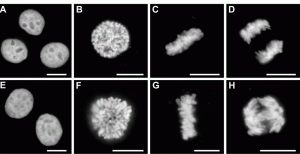A new and improved green fluorescent protein, named mNeonGreen, was developed.
It was engineered from a Yellow fluorescent protein (LanYFP) that was isolated from the cephalochordate Branchiostoma lanceolatum. Therefore, LanYFP is genetically unrelated to the commonly used Aequorea victoria GFP.
LanYFP has a high quantum yield (0.95) and extinction coefficient (~150,000 M−1 cm−1) – making it a very bright protein. LanYFP is a tetramer – not useful for most applications.
Directed evolution to make it a monomer produced the new, monomeric protein, mNeonGreen. The ex/em of mNeonGreen is slightly shifted to the yellow compared to EGFP (509/516 compared to 488/509), making it a better choice to separate from CFP emission.
Though slightly less brighter than its parent protein LanYFP, mNeonGFP is 2-3 times brighter than EGFP and actually brighter than most green & yellow proteins.
Another great advantage of this new protein is that is it fast folding – the authors claim it is <10 min at 37C. This is fairly close to the superfolder GFP.
It is also very photostable (comparable to EGFP), performs well as a fusion construct at N & C termini many tested proteins, performs 4-times better that EGFP in stochastic single-molecule superresolution imaging and is a better FRET partner (both as acceptor and donor) than other proteins.

mNeonGreen fused to histone H2B shows the different stages of the chromosomes during cell division. Source: Shaner et al., (2013) Nature Methods 10:407-409.
In short, this may very well be the “next generation” of fluorescent proteins. It has all the good qualities, and seems to have none of the bad ones. It performs better than most, if not all fluorescent proteins in every tested parameter.
Only its name is rather plain. I would call it something like wonderGFP or GreenLantern (hey, it even has the Lan from the animal they developed it from).
(Update: see here for details on how to get your hands on this protein).
![]() Shaner NC, Lambert GG, Chammas A, Ni Y, Cranfill PJ, Baird MA, Sell BR, Allen JR, Day RN, Israelsson M, Davidson MW, & Wang J (2013). A bright monomeric green fluorescent protein derived from Branchiostoma lanceolatum. Nature methods, 10, 407-409 PMID: 23524392
Shaner NC, Lambert GG, Chammas A, Ni Y, Cranfill PJ, Baird MA, Sell BR, Allen JR, Day RN, Israelsson M, Davidson MW, & Wang J (2013). A bright monomeric green fluorescent protein derived from Branchiostoma lanceolatum. Nature methods, 10, 407-409 PMID: 23524392








Looking good! Thanks for this post. I wonder how easy is to get our hands on it.
LikeLike
Well, it should be their interest that other people will use it, so I think asking them directly for plasmids would be the easiest way.
LikeLike
I just found out: they published their distribution protocol here: http://blog.allelebiotech.com/2013/04/the-development-of-mneongreen/
LikeLike
Reblogged this on Medical Minded.
LikeLike
I don’t know. We made stable human iPSCs expressing P2A-mNeonGreen and P2A-eGFP and eGFP was appreciably brighter. I was very hopeful we had a winner. Not sure why but our experience doesn’t really jive with the reportedly 3X brighter Neon signal. Possible cell type specific differences? Interference with P2A? Just don’t know. BTW – we used a standard GFP filter or FITC filters for detection and an XCITE broad spectrum light source for excitation.
LikeLike
That’s disapointing. I assume you checked there are no mutations in your construct. If it is not a cell-type of fusion protein issues, then I can only guess that maybe it is a matter of filters. Remember that mNeon is slightly yellow-shifted compared to GFP. Did you try a YFP filter?
LikeLike
should probably also check the codon usage of the flourescent protein – can make a big difference to expression levels
LikeLike
Pingback: Design guidlines for tandem fluorescent timers | greenfluorescentblog
Pingback: Troubles with mCherry | greenfluorescentblog